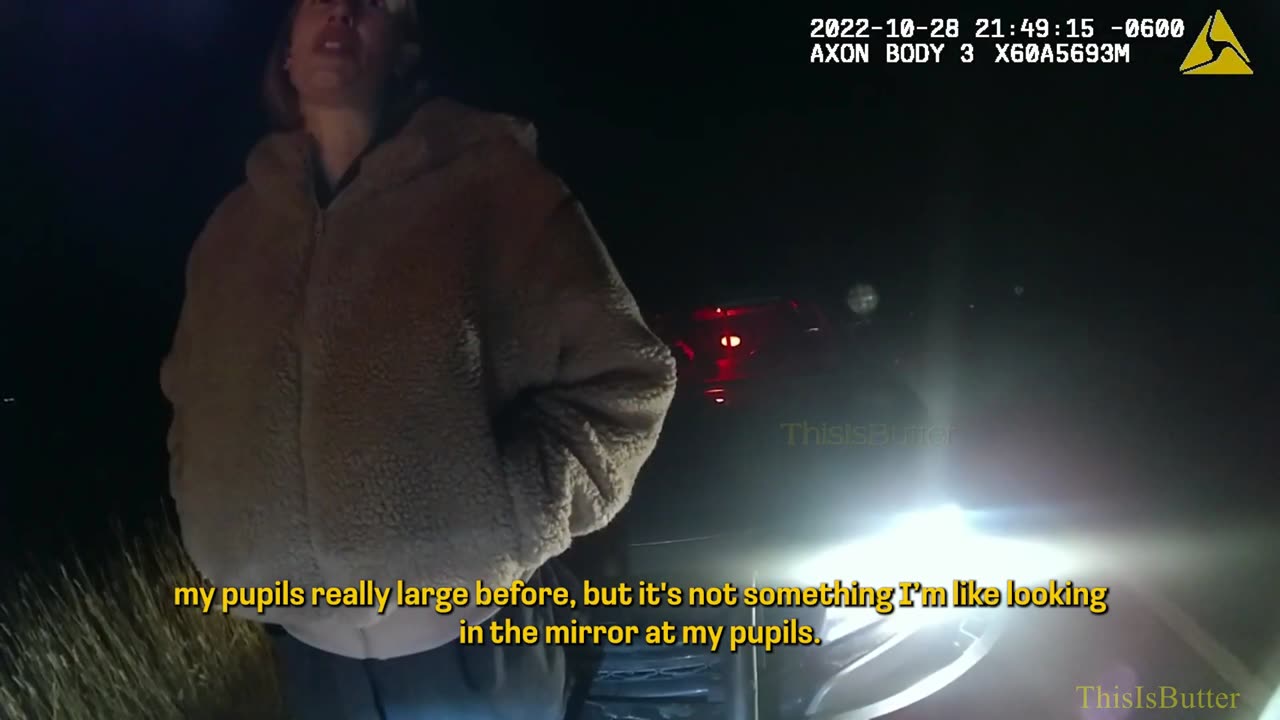Premium Only Content

Bodycam shows Haley Butler-Moore being pulled over and doing a DUI test by a Drug Recognition Expert
Finding videos takes time and effort, keep me motivated by donating to https://paypal.me/thisisbutter
-----
Haley Butler-Moore sped up to pass a semi on the highway when she suddenly saw the police lights.
She’d left Albuquerque hours earlier, heading to a Halloween party in Denver. Tired from the long drive, she recalled being nervous as she pulled out her paperwork. The trooper asked Butler-Moore to come sit in the patrol car.
“Do you use any recreational drugs?” asked the officer, as captured on the body camera.
“No,” said Butler-Moore.
“OK, because your eyes are saying something completely different. So how much have you used today?”
“None. I’m a little hypoglycemic and nervous.” Butler-Moore, who is a nurse, added: “I take antidepressants. I take acne medications.”
After a roadside test, where the officer said Butler-Moore asked for directions too often and noted that her eyes fluttered at one point, the officer drove her to the Colorado state patrol office in Walsenburg. There, police turned Butler-Moore over to a certified Drug Recognition Expert, an officer specially trained to tell who is high and on exactly what drugs.
“I asked her if she would be willing to perform advanced roadside tests with a DRE and (she) was eager to do so,” wrote the arresting officer.
Looking back on that night in 2022, Butler-Moore said she wouldn’t have cooperated if she knew what DRE was or what would happen next.
“I agreed to it, but I didn’t understand that at that point it was already over,” said Butler-Moore.
The DRE officer began a little known, federally funded 12-step assessment that police across the country say helps decide who is unsafe to drive and who ingested exactly which drugs based on a collection of clues gathered by staring into suspects’ eyes, pinching their muscles, taking their blood pressure and watching closely how they walk and talk and balance.
“It’s such utter nonsense,” said Sarah Schielke, Butler-Moore’s attorney in Colorado. “A cop can use it to manufacture whatever conclusion of impairment they want.”
At the police station, the DRE officer, one of more than 8,000 scattered in departments across the country, asked Butler-Moore to recount everything she did that day.
“If there is no impairment, it will come out here,” the officer told her, the entire evaluation recorded on bodycam.
But the officer had concerns. Butler-Moore had put the wrong date, from the day before. That’s because, Butler-Moore said, she didn’t realize it was already after midnight.
“I’m also paying attention to what you are telling me,” said Sgt. Carrie Jackson. “I’m seeing a lack of smooth pursuit, which is horizontal gaze nystagmus.”
That’s the scientific term DRE officers use to describe jerky eye movements. Jackson said she noticed some horizontal twitches, which the DRE training material says could be caused by prescription meds. But she also saw some vertical jitters, which the officer said might indicate marijuana.
If a DRE officer decides that a driver was unsafe at the wheel, that can lead to a charge for driving while impaired and a trip to jail. And in many states, DRE officers can testify at trial as a sort of human breathalyzer, stating as a fact that their testing showed someone was on drugs and too high to drive.
-
![GrayZone Warfare: NightOp [GAME GIVEAWAY!] - #RumbleGaming](https://1a-1791.com/video/s8/1/s/1/R/D/s1RDv.0kob-small-GrayZone-Warfare-NightOp-GA.jpg)
LumpyPotatoX2
3 hours agoGrayZone Warfare: NightOp [GAME GIVEAWAY!] - #RumbleGaming
26.5K2 -
 2:25:44
2:25:44
WeAreChange
4 hours agoAliens?! Pentagon Shoots Down Iranian Mothership Drone Narrative
61.1K17 -
 59:34
59:34
The StoneZONE with Roger Stone
2 hours agoShould the January 6th Committee be Investigated? | The StoneZONE w/ Roger Stone
22K4 -
 44:34
44:34
PMG
3 hours ago $0.51 earned"Caitlin Clark Says She Has “White Privilege” Why Caitlin WHY???"
13.7K2 -
 1:06:50
1:06:50
Dr. Drew
10 hours agoRoger Ver, Jan 6ers, Ross Ulbricht: Who Should Trump Pardon First? w/ Robert Barnes & Aaron Day – Ask Dr. Drew
39.7K4 -
 11:56
11:56
Tundra Tactical
4 hours ago $1.38 earnedWas the UnitedHealthcare CEO Assassination a PSYOP?
18.3K10 -
 52:46
52:46
Sarah Westall
3 hours agoPower of Nocebo and Placebo in Health & Politics. Quantum Energy Advancements w/ Ian and Philipp
26.9K4 -
 54:59
54:59
LFA TV
1 day agoLee Smith Discusses ‘Disappearing the President’ | Trumpet Daily 12.11.24 7PM EST
22.4K -
 1:48:15
1:48:15
2 MIKES LIVE
5 hours ago2 MIKES LIVE #154 w/ Spcieal Guests, BRIANNE DRESSEN, DAN SMERIGLIO and ADAM DERITO!
13.1K -
 1:28:46
1:28:46
Redacted News
6 hours agoBREAKING! CIA DEEP STATE PLAN TO STOP TRUMP ACCELERATES WITH FALSE FLAGS TIED TO IRAN | REDACTED
161K351